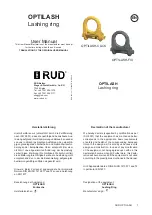
2
RUD OPTILASH
Read the User Manual carefully before
using the RUD OPTILASH lashing ring.
Ensure that you have understood all the
contents.
Non-observation of the instructions can
lead to injuries or damage and will invali-
date the guarantee.
These instructions apply to the following variants of
the OPTILASH lashing ring:
•
OPTILASH-FIX
:
in one piece
OPTILASH-CLICK
:
click-in version
(with spring-loaded pin)
NOTE
The User Manual for the OPTILASH-FIX
and OPTILASH-CLICK lashing rings only
contains information about the lashing rings
themselves.
Any installation link necessary is not includ-
ed in the scope of delivery / delivery range
and has to be provided by the operator in
accordance with the requirements!
1 Safety information
CAUTION
Incorrectly mounted or damaged lashing
equipment and improper use can lead to
injuries and damage to objects after a fall.
Check all lashing equipment carefully every
time before use.
• The RUD OPTILASH may only be used for the
attachment of lashing equipment.
• Lashing points must never be used for lifting loads.
• The RUD OPTILASH may only be used by author-
ised and instructed persons in compliance with
DGUV Regulations 100-500 chapter 2.8 (BGR 500)
and in compliance with any valid national regula-
tions if used outside Germany.
• The LC (= Lashing Capacity) specified on the OP
-
TILASH must not be exceeded.
• No technical modifications must be made to the
RUD OPTILASH.
• Damaged or worn RUD OPTILASH units must not
be used.
2 Intended use
The RUD OPTILASH may only be used for the at-
tachment of lashing equipment.
Lashing points must never be used for lifting loads.
In addition, the RUD OPTILASH may only be sub-
jected to a load up to the maximum stipulated LC =
Lashing Capacity.
All-round load is permitted.
The RUD OPTILASH may only be used for the pur-
poses described here.
3 Instructions for assembly and use
3.1 General information
• Suitability for use at specific temperatures:
•
OPTILASH-FIX:
When used at higher temperatures, the WLL
must be reduced by the following factors:
• -40°C to 200°C: no reduction
• 200°C to 300°C: minus 10 %
• 300°C to 400°C: minus 25 %
• Temperatures over 400°C are not
permissible!
•
OPTILASH-CLICK:
• -40°C to 80°C: no reduction
• Temperatures over 80°C are not
permissible (failure of the springs)!
• RUD OPTILASH must not be allowed to come into
contact with aggressive chemicals, acids and their
vapours.
• Clearly identify the attachment place for the lashing
points by means of contrasting colour markings.
• RUD OPTILASH are marked on the attachment
ring with the permissible lashing capacity “LC” in
daN.
• Determine the necessary permissible lashing
capacity of the individual lashing point in accord-
ance with EN 12195-1 “Load restraining on road
vehicles - Calculation of securing forces” and VDI
2700 “Load restraining on road vehicles”.
NOTE
RUD OPTILASH is marked on the hooking
ring with the permissible lashing capacity
“LC” in daN.
3.2 Information about assembly
• Design the attachment point so that the exerted
forces can be absorbed by the base material with-
out deformation.
Fig. 1
Fig. 2
Bolt
Actuating
slide

























